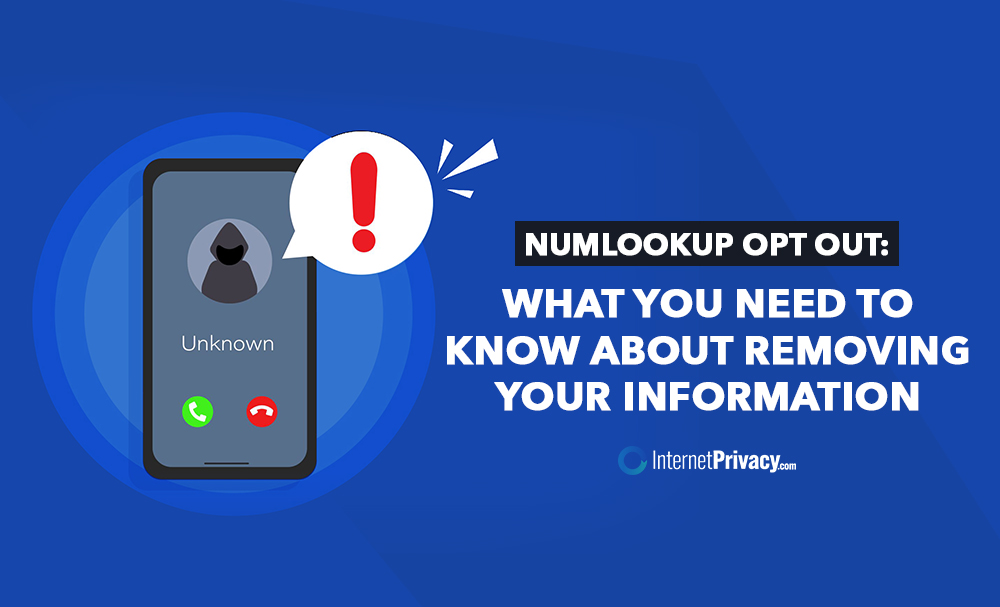NumLookup Opt Out: What You Need to Know About Removing Your Information

Protecting your personal information is more important than ever. NumLookup is a popular reverse phone lookup service that collects and shares user data, which can lead to privacy worries for many, especially in light of the California Consumer Privacy Act.
What Is NumLookup Opt Out?
NumLookup Opt Out is a way for individuals to remove their personal information from the NumLookup database, which gathers publicly available data for reverse phone lookups and other tracking services. By opting out, you can protect your privacy and lower the risk of identity theft or cyberstalking from data brokers. This process empowers you to take charge of your online presence and enhance your privacy rights, giving you more control over your personal information.
Why Would Someone Want to Opt Out of NumLookup?
People opt out of NumLookup for several reasons, mainly related to privacy and protecting their personal information from misuse, identity theft, or unwanted spam calls—growing awareness of the risks associated with being visible online drives these concerns. For many, the fear of identity theft leads to a desire to safeguard their details, especially as data aggregation practices pull information from public records and telecom companies.
There are also worries about how this data might be used for malicious purposes and the impact of targeted advertising, which can feel intrusive when people receive unsolicited communications. Ultimately, individuals seek greater control over their personal data and digital footprint. In our interconnected world, each decision to protect one’s information highlights the urgent need for robust privacy measures that empower users to reduce their exposure and enhance their security.
How Does NumLookup Collect and Use Personal Information?
NumLookup gathers personal information from multiple sources, mainly relying on data brokers and publicly available records. This information is used for reverse phone lookups, background checks, and identity monitoring. However, this practice raises significant privacy concerns for consumers, as it can jeopardize their information security and potentially misuse their personal data.
What Information Does NumLookup Collect?
NumLookup collects a wide range of personal information that poses serious privacy risks for individuals, including:
- Phone numbers
- Addresses and location details
- Business records and account information
- Sensitive data such as social security numbers and photo identification
- Home and work addresses
- Emails and contact details
- Professional associations and job titles
- Criminal records, if any
- Patterns of social interactions and affiliations
This extensive collection reflects how readily available personal information can be online. By aggregating factual identifiers, public records, and sensitive financial information, NumLookup increases the risks of identity theft, stalking, and other malicious activities. The visibility of such data makes individuals vulnerable to exploitation, highlighting the urgent need to understand the implications of this data exposure.
How Does NumLookup Use Personal Information?
NumLookup primarily uses collected personal information to offer services like reverse phone lookup and background checks. It draws data from various brokers to build detailed profiles that both consumers and businesses can access. While these services help users quickly identify unknown callers and gain insights into individuals’ backgrounds—enhancing safety and informed decision-making—they also raise significant privacy concerns.
For example, the reverse phone lookup feature allows individuals to verify the identity of callers, which can help prevent scams and unwanted contact. However, the information used may include sensitive data, leading to risks such as:
- Identity theft: Detailed personal data can be exploited for fraudulent activities.
- Cyberstalking: Accessible information might enable harmful behavior against vulnerable individuals.
While NumLookup provides valuable tools, it’s essential to approach their usage cautiously and prioritize strong data protection practices to mitigate privacy risks.
How to Opt Out of NumLookup?
Step 1: Visit the NumLookup Opt-Out Page
The first step to opting out of NumLookup is to go to their dedicated opt-out page on their website. This page is crucial for ensuring your personal information is removed from their database, helping you safeguard your privacy. To find it, look for the ‘Help’ or ‘Opt-Out’ link in the footer of the homepage, or use the search bar if you can’t see it right away. The website is designed to be user-friendly, providing clear instructions to guide you through the process, making it easy to manage your online exposure.
Step 2: Enter Your Phone Number
Once you’re on the opt-out page, the next step is to enter your phone number. This allows NumLookup to find your information in their database for removal. It’s important to input your phone number correctly, as mistakes can prevent your records from being seen. Follow the specified format, including the area code and correct digit separation. To avoid issues, double-check your entry for typos, refrain from using special characters unless instructed, and pay attention to the required format. This accuracy is essential for swiftly removing your information from their databases.
Step 3: Complete the Verification Process
After entering your phone number, you must complete a verification process, which usually involves a CAPTCHA challenge. This step is important for confirming your identity and ensuring only authorized users can request data removal. It helps enhance security by blocking malicious attempts to access sensitive information. The CAPTCHA acts as a barrier against bots, while identity verification methods reinforce trust, ensuring your data is protected through rigorous safeguards. You can feel secure knowing that this process maintains your privacy.
Step 4: Confirm Your Opt-Out Request
The final step is to confirm your opt-out request, which may involve receiving an email or notification to verify that your request has been processed. This confirmation is essential to ensure your preference is formally acknowledged. Keep an eye on your email for a confirmation message, often including a link or code you need to finalize your request. Save this confirmation for your records as proof of your decision to opt-out. If you don’t receive confirmation in a timely manner, consider contacting customer support to verify that your request was processed correctly. Maintaining records of your confirmations helps you track progress and provides peace of mind about your data privacy.
What Happens After You Opt Out of NumLookup?
Once you’ve successfully opted out of NumLookup, your personal information should be removed from their database. This will give you greater privacy and reduce the risk of identity theft and online scams. NumLookup takes care to ensure that your information removal is comprehensive.
After completing the opt-out process, you’ll receive a confirmation that your request was successful. The data removal generally takes about 48 hours to be fully processed. During this time, you might notice that your information is no longer available on the platform, significantly boosting your online anonymity. The process also includes a CAPTCHA challenge to verify your identity before data removal.
It’s important to recognize that opting out protects your personal details and reduces the chances of receiving unwanted communications and potential scams. These measures are crucial for safeguarding your identity in a digital landscape where data breaches are becoming more frequent. You may need to navigate several steps on the website to ensure all your personal information is thoroughly erased.
- Confirmation: Expect a notification about the removal.
- Processing Time: Typically within 48 hours.
- Implications: Enhanced privacy and decreased risk of identity theft.
Are There Any Risks to Opting Out of NumLookup?
Opting out of NumLookup can significantly reduce the risk of your personal information being accessed by data brokers, but it doesn’t eliminate all online privacy risks. Your data may still be re-collected or shared through other channels, making it crucial to understand the complexities of data privacy. Many users mistakenly believe that opting out fully secures their data; however, information can easily resurface if other companies gather it from various sources.
To address these concerns, consider using identity monitoring services like PurePrivacy, which can help monitor your personal information. It’s also important to recognize the limitations of the opt-out process, as some data brokers have vague policies or require regular re-verification, complicating privacy efforts.
Individuals should regularly check their online presence and stay informed about data privacy trends to stay protected. Using tools that enhance security is also essential. Maintaining online privacy requires a proactive approach and vigilance to guard against potential breaches.
Is Opting Out of NumLookup Enough to Protect Your Personal Information?
Opting out of NumLookup is important in protecting your personal information, but it’s insufficient. To truly secure your online privacy against identity theft and data aggregation—especially under the California Consumer Privacy Act guidelines—you should adopt a more comprehensive approach. Relying solely on a single platform can create gaps in your privacy coverage.
Consider implementing various strategies to enhance your security. Start by using tools that monitor data collection by brokers and search engines. It’s also essential to employ strong, unique passwords for each account and enable two-factor authentication to add an extra layer of protection. Regularly checking your bank and credit accounts for unauthorized transactions can help you spot suspicious activity early.
Additionally, privacy-focused browser extensions can block trackers and ads, reducing data collection. Staying informed about the latest identity theft tactics and privacy technologies will bolster your defenses. Creating a well-rounded personal information protection strategy can significantly lower your identity theft risk and ensure greater online safety. Setting up alerts can keep you updated on potential data breaches involving your information.
What Other Steps Can You Take to Protect Your Personal Information Online?
To better protect your personal information online, consider implementing additional strategies such as using identity monitoring services like PurePrivacy or Incogni. These services can actively track suspicious activities related to your data and send you alerts, significantly lowering the risk of identity theft and data breaches.
Start by leveraging these reputable services and complementing them with secure browsing practices, such as incognito modes and VPNs. Regularly updating your passwords and enabling two-factor authentication will provide another layer of protection. Additionally, frequently checking your bank and credit accounts can help you quickly identify unauthorized activity.
Staying informed about your privacy rights and understanding local data protection laws empower you to take control of how your information is managed. By combining these strategies, you can create a more secure online environment. Using identity monitoring services and privacy-focused browser extensions will minimize data collection and enhance security.





